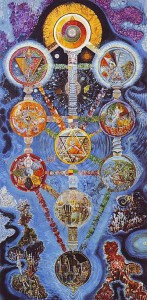 I teach a lot of classes about Kabbalah, but I don’t think I’ve ever done a real post about it; at least, I haven’t in a while… Part of it, I suppose, is that I do believe there’s more information transmitted energetically when a teaching is given mouth-to-ear, as it were. Part of it is that I have always assumed that people who are interested in Kabbalah will come take a class. I am feeling called to write a post about it, though, so I’m going to honor that.
I teach a lot of classes about Kabbalah, but I don’t think I’ve ever done a real post about it; at least, I haven’t in a while… Part of it, I suppose, is that I do believe there’s more information transmitted energetically when a teaching is given mouth-to-ear, as it were. Part of it is that I have always assumed that people who are interested in Kabbalah will come take a class. I am feeling called to write a post about it, though, so I’m going to honor that.
Kabbalah is a mystical philosophy, like Buddhism. I don’t feel like it contradicts belief systems; rather it works in concert with them. There are threads of Kabbalah throughout the Abrahaamic religions, and I see parallels with eastern philosophies as well. As a mystical philosophy, the teachings are designed to help the seeker to have an experience of the Divine. That experience cannot be handed to you, it’s personal for each person (which is the definition of mysticism). I (or any skilled teacher) can give you the tools to get there, though.
A lot of Kabbalah practice and teachings are centered around the Tree of Life, which is the graphic that accompanies this post. It’s a glyph that I consider to be a shorthand for everything – aspects of self, aspects of the Divine, how the world works, connecting with the Divine, manifestation… Everything. The teachings just help you unpack all of that information. There are different ways of dividing it up so the information gets ordered differently, which give you new pieces of information. It’s pretty fascinating, really, especially for someone as data-driven as I am. Every time I teach it, I get a new insight, a new piece of information, a new experience. Teaching Kabbalah has become as much a part of my practice as any other tool, possibly more so. Many of my students will take my Level 1 year-long class more than once, before moving on to level 2 and level 3. One of my students did level 1 and 2 in succession, then did a year of independent study before moving on to level 3, which is Pathworking. Some people only attend my talks and meditations, because that’s all they feel ready to commit to.
As an example of one way to look at the Tree: The two outer pillars, first and foremost, address the energy that makes up all matter. Energy has a push and a pull; that’s what defines it. No motion means no energy, and no matter. That same push and pull, on a personal level, are ways of looking at the qualities of action, of thought, of perception, of being. The left side of the Tree is about limitations and boundaries and receptivity, about the pull mechanism of the energy. The right side of the Tree is about energy and creativity and action, about the push aspect of the energy. As humans, it’s unlikely we’re every going to be all the way to one end or the other of the spectrum, so we’re always moving between the outer pillars. People who aspire to balance aspire to the middle pillar; but there’s always going to be motion, we’re never static in that space. Even the push and the pull aspects are always in motion – sometimes the left side of the tree gathers energy or information in, sometimes it cuts away that which is no longer needed; sometimes the right side of the tree creates, and sometimes it explosively destroys.
And that is just a tiny nibble of the teachings of Kabbalah.
There are books you can read about Kabbalah, although I have found that they’re frequently dense and hard to get into if you haven’t studied any of it yet (and sometimes even if you have). Some of the ones that aren’t overly esoteric are too simplistic to help you have a mystical experience. And, as I said at the beginning of this article, having an in-person teacher gives you an experience the written word cannot. Finding a teacher with whom you resonate is equally as important. There are an infinite ways of imparting the information – you want to find the technique and the teacher that make the lightbulb in your head light up. Put the energy out there, if you are interested in pursuing Kabbalah teachings more, and the Universe will likely put the right tools and teacher in front of you.